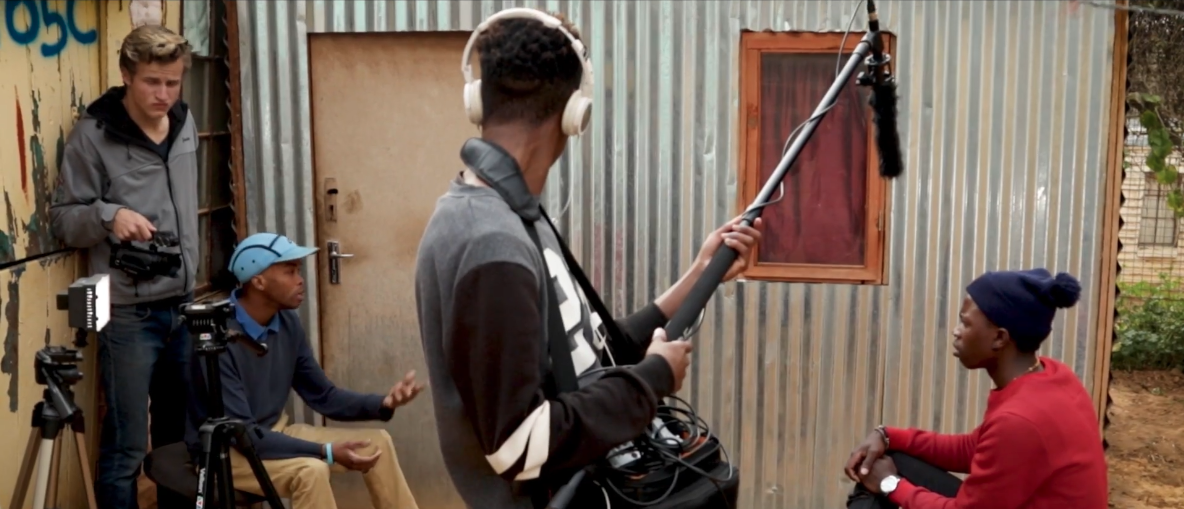
Film School Africa is about the passion of following your dreams. It raises an important question: what if your dreams aren’t realistic? That question is central to the story. Here we have young Africans in the township of Kayandi. The elders here view filmmaking as something unrealistic for a young person to attain to achieve. Filmmaking, for a large part of history, has been a field primarily an employer for white people. Here in America, a major studio invested in one of the first black, but not African American, characters and gave him a motion picture in 2018.
African Americans in America went through a painful segregation that ended in 1964. Film School Africa was made in a place where the horrible system known as apartheid ended in 1991. How can the Kayandin youth ever dream to be filmmakers? Thankfully Film School Africa is an organization that empowers the youth of Kayandi through imparting the crafts of storytelling for film. The organization’ss director, Katie Taylor from Hollywood reaches a hand into the rough townships to teach filmmaking.
Katie Taylor gave up a lucrative career in Hollywood. She moved to South Africa to break down color barriers. She works alongside a staff, as she imparts the tools of filmmaking to the students of Film School Africa. The documentary follows several different South Africans as they write, shoot, and edit their first film.
The footage is well shot from the crew of Film School Africa. The footage shot by the young filmmakers is admirable. They show promise in their efforts to make their first film. Sadly one of the young filmmakers highlighted in Film School Africa is killed trying to break up a fight between his sister and some guy. The townships are dangerous.
It is a testament to the passion of Katie Taylor that she ventured into the townships and established this filmmaking program. Knowing Malathise died, I kind of want to know more about him. But then again I’m sure the filmmakers of Film School Africa spent equal time recording their talent, so when it comes to Malathise’s death what we get is well enough. The weight of his passing is handled well.
There was one kid in the documentary named Juan. Unlike the other students, he was white and was not from the Townships. But he sure had to venture there alongside his fellow filmmaking students after they’re paired together on a project. I felt for that kid. Though I’ve never been to a township myself, I am aware the projects are historically not a place anyone has been excited about venturing to. So as an American, seeing Juan roll up the car windows, nervously swear, and glance around nervously was totally relatable.
I recommend this documentary to anyone looking for an inspiring story about the power of filmmaking to connect.
FINAL GRADE: B
Don’t forget to share this post on your Facebook wall and with your Twitter followers! Just hit the buttons on the top of this page.
—–
Have you checked out LRM Online’s official podcast feed yet The LRM Online Podcast Network, which includes our flagship podcast Los Fanboys, our premiere podcast Breaking Geek Radio: The Podcast, and our morning show LRMornings? Check it out by listening below. It’s also available on all your favorite podcast apps!
Subscribe on: Apple Podcasts | Spotify | SoundCloud | Stitcher | Google Play
 FOR FANBOYS, BY FANBOYS
Have you checked out LRM Online’s official podcasts and videos on The Genreverse Podcast Network? Available on YouTube and all your favorite podcast apps, This multimedia empire includes The Daily CoG, Breaking Geek Radio: The Podcast, GeekScholars Movie News, Anime-Versal Review Podcast, and our Star Wars dedicated podcast The Cantina. Check it out by listening on all your favorite podcast apps, or watching on YouTube!
Subscribe on: Apple Podcasts | Spotify | SoundCloud | Stitcher | Google Play
FOR FANBOYS, BY FANBOYS
Have you checked out LRM Online’s official podcasts and videos on The Genreverse Podcast Network? Available on YouTube and all your favorite podcast apps, This multimedia empire includes The Daily CoG, Breaking Geek Radio: The Podcast, GeekScholars Movie News, Anime-Versal Review Podcast, and our Star Wars dedicated podcast The Cantina. Check it out by listening on all your favorite podcast apps, or watching on YouTube!
Subscribe on: Apple Podcasts | Spotify | SoundCloud | Stitcher | Google Play



